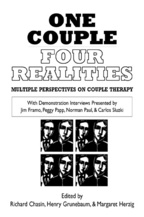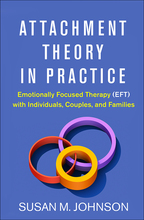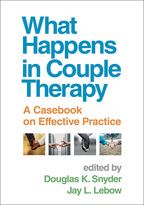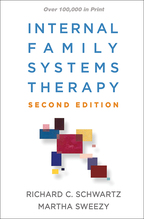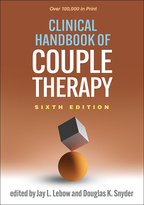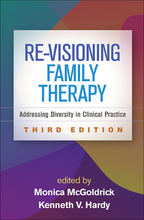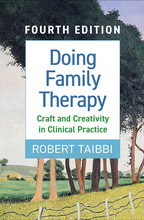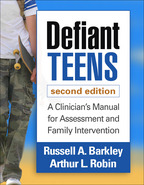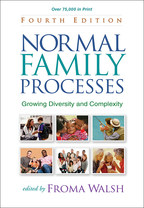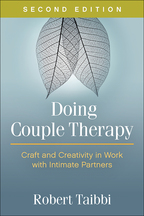One Couple, Four Realities
Multiple Perspectives on Couple Therapy
Edited by Richard Chasin, Henry Grunebaum, and Margaret Herzig
Paperback
Paperback
orderMarch 1, 1992
ISBN 9780898620290
Price: $66.00 420 Pages
Size: 6⅛" x 9¼"
Copyright Date: 1990
Sign up for emails on upcoming titles on Families & Couples (with special discounts)!
“Stimulating...would clearly enhance any advanced course on marital and family therapy from a practice, research, or training perspective.”

—Contemporary Psychology
“By far! The best available demonstration of the multiple perspectives of couples therapy.”

—Phil Striegel, The University of Iowa, Iowa City
“I've used the book several times for a course in Marital Therapy (I taught the same course two times). What I like about it is that it gives a breadth of different schools of therapy. While looking at the same case, the authors give their comments on the process at the same time. I also really appreciate the ethical concerns raised by this book, even to the point of the authors saying they might not do it again. This type of self critical, self reflexive perspective is very beneficial. My students have found it to be very useful and very understandable, particularly the chapter on contextual therapy.”

—Jerry Gale, Ph.D., University of Georgia
“The book's strength is being able to communicate similarities and differences between different theoretical models in conceptualizing behavior. It shows different interpretations of the same basic concepts which helps students understand theories better. The book is extremely well written and I found it to be very useful on the graduate school level.”

—Margaret Crosbie-Burnett, Ph.D., University of Miami
“Now, from that intellectual summit of couples' treatment—the annual Harvard Couple Therapy Conference—has come this remarkable Rashomon-like narrative. One Couple, Four Realities is a bit of a clinical thriller: sophisticated, ever and ever more revealing, and thoroughly absorbing throughout.”

—Maggie Scarf, author of Intimate Partners
“Startling and dramatic! These were my reactions to reading these reports by four therapists who consulted with the same couple. This volume makes vividly and undeniably clear how radically different these therapists are. In addition, comments by a number of other therapists document starkly differing perspectives about the same clinical material. Further, the comments of the clients themselves immediately after the consultations, and again after 6 months and 6 years, convey distinctive perceptions and sobering, surprising, afterthoughts about the meaning of these consultations for them and their families of origin. Finally the editors conclude with badly needed, thought-provoking reflections on the ethics of using demonstration interviews and tapes for the teaching of therapy. This volume should and will stimulate challenging debate not only among therapists, but also among training program directors, and, all who participate in demonstration interviews, including the couples and families themselves.”

—Lyman C. Wynne, M.D., Ph.D., author of Systems Consultation
“Here is surely a book for the constructivist age! A fascinating study of multiple perspectives....Most provocative and intriguing is the couple's own feedback on the experience at three points in their later lives....This book is unique for the multiplicity of perspectives provided on the same family across points of view and through time. It will make you rethink your own caseload....”

—Monica McGoldrick, M.S.W., author of Ethnicity and Family Therapy
“I've used this book several times for a course in Marital Therapy. What I like about it is that it gives a breadth of different schools of therapy. While looking at the same case, the authors give their comments on the process at the same time. I also really appreciate the ethical concerns raised by this book....This type of self critical, self reflexive perspective is very beneficial. My students have found it to be very useful and very understandable, particularly the chapter on contextual therapy.”

—Jerry Gale, Ph.D., University of Georgia
“The book's strength is being able to communicate similarities and differences between different theoretical models in conceptualizing behavior. It shows different interpretations of the same basic concepts which helps students understand theories better. The book is extremely well written and I found it to be very useful on the graduate school level.”

—Margaret Crosbie-Burnett, University of Miami
—Contemporary Psychology
“By far! The best available demonstration of the multiple perspectives of couples therapy.”
—Phil Striegel, The University of Iowa, Iowa City
“I've used the book several times for a course in Marital Therapy (I taught the same course two times). What I like about it is that it gives a breadth of different schools of therapy. While looking at the same case, the authors give their comments on the process at the same time. I also really appreciate the ethical concerns raised by this book, even to the point of the authors saying they might not do it again. This type of self critical, self reflexive perspective is very beneficial. My students have found it to be very useful and very understandable, particularly the chapter on contextual therapy.”
—Jerry Gale, Ph.D., University of Georgia
“The book's strength is being able to communicate similarities and differences between different theoretical models in conceptualizing behavior. It shows different interpretations of the same basic concepts which helps students understand theories better. The book is extremely well written and I found it to be very useful on the graduate school level.”
—Margaret Crosbie-Burnett, Ph.D., University of Miami
“Now, from that intellectual summit of couples' treatment—the annual Harvard Couple Therapy Conference—has come this remarkable Rashomon-like narrative. One Couple, Four Realities is a bit of a clinical thriller: sophisticated, ever and ever more revealing, and thoroughly absorbing throughout.”
—Maggie Scarf, author of Intimate Partners
“Startling and dramatic! These were my reactions to reading these reports by four therapists who consulted with the same couple. This volume makes vividly and undeniably clear how radically different these therapists are. In addition, comments by a number of other therapists document starkly differing perspectives about the same clinical material. Further, the comments of the clients themselves immediately after the consultations, and again after 6 months and 6 years, convey distinctive perceptions and sobering, surprising, afterthoughts about the meaning of these consultations for them and their families of origin. Finally the editors conclude with badly needed, thought-provoking reflections on the ethics of using demonstration interviews and tapes for the teaching of therapy. This volume should and will stimulate challenging debate not only among therapists, but also among training program directors, and, all who participate in demonstration interviews, including the couples and families themselves.”
—Lyman C. Wynne, M.D., Ph.D., author of Systems Consultation
“Here is surely a book for the constructivist age! A fascinating study of multiple perspectives....Most provocative and intriguing is the couple's own feedback on the experience at three points in their later lives....This book is unique for the multiplicity of perspectives provided on the same family across points of view and through time. It will make you rethink your own caseload....”
—Monica McGoldrick, M.S.W., author of Ethnicity and Family Therapy
“I've used this book several times for a course in Marital Therapy. What I like about it is that it gives a breadth of different schools of therapy. While looking at the same case, the authors give their comments on the process at the same time. I also really appreciate the ethical concerns raised by this book....This type of self critical, self reflexive perspective is very beneficial. My students have found it to be very useful and very understandable, particularly the chapter on contextual therapy.”
—Jerry Gale, Ph.D., University of Georgia
“The book's strength is being able to communicate similarities and differences between different theoretical models in conceptualizing behavior. It shows different interpretations of the same basic concepts which helps students understand theories better. The book is extremely well written and I found it to be very useful on the graduate school level.”
—Margaret Crosbie-Burnett, University of Miami

